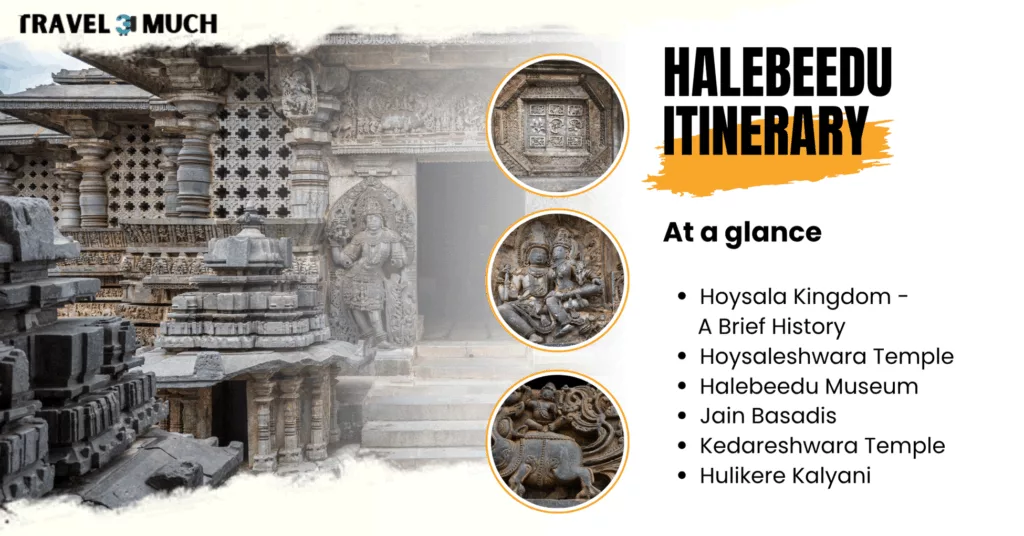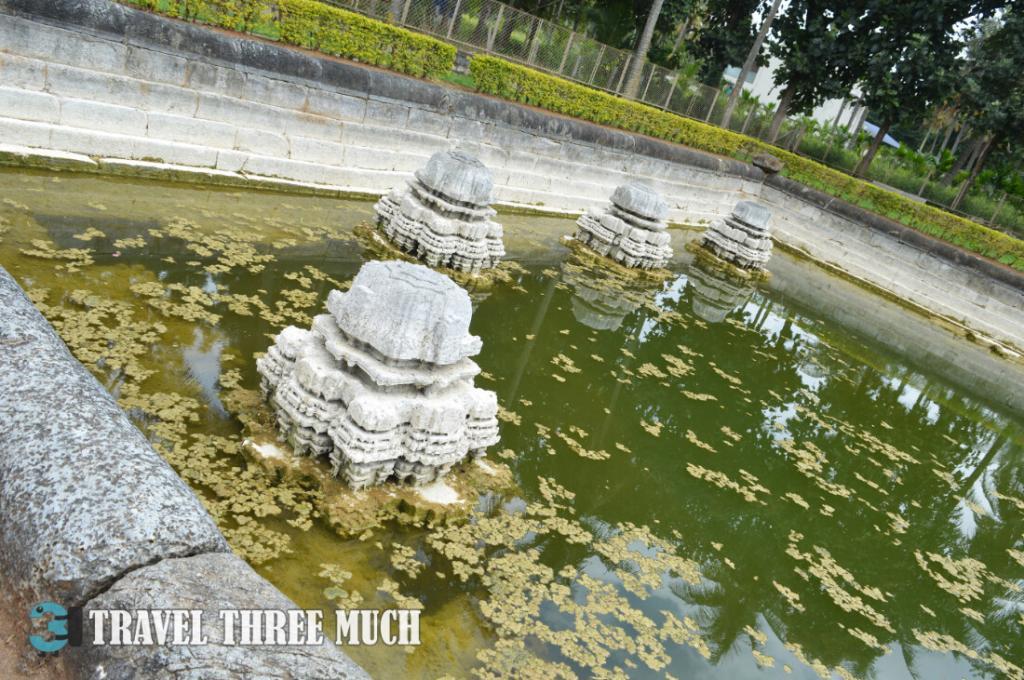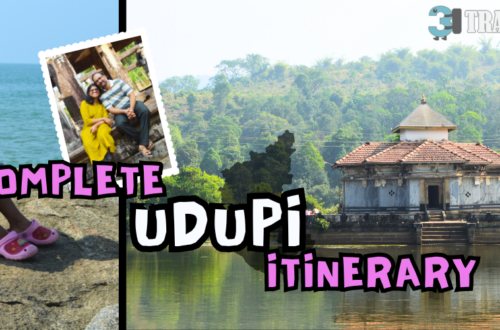
The besieged ocean, Dwarasamudra – Halebeedu itinerary
The Hoysala kingdom was a dynasty between the 10th and 14th centuries CE. The dominion spanned most of present-day Karnataka, as well as parts of Tamil Nadu and Telangana. The capital city of the kingdom shifted with the changing fortunes, like many other dynasties. The capital was originally located in Sosavur, but it was later moved to Belur before settling in the present-day Halebidu. Originally called Dwarasamudra (and also Dvaravatipura), Halebidu remained the Hoysalas’ capital from 1062 CE until the dynasty’s decline around the 14th century CE. The Hoysaleshwara Temple in Halebidu is one of the crowning achievements of Hoysala art and architecture. The other two are at Belur and Somnathpura. The Halebidu temple is dedicated to the Hindu god Shiva. It was designated a UNESCO World Heritage Site in 2023, as part of the ‘Sacred Ensembles of the Hoysalas’. Other lesser-known monuments scattered around the temple are a reminder of the grand spectacle that the settlement was in its heyday. Halebidu is also one of the stops of the Golden Chariot – one of the many luxury tourist trains run by the Indian Railways.

Hoysala Kingdom – A Brief History
The beginnings of the Hoysala kingdom have two facets. Kannada folk tales speak of a youth named Sala, who protected his Jain mentor Sudatta from the attack of a tiger (or sometimes a lion) by slaying the beast with his sword. It is said that Sudatta exhorted him to kill the beast with his sword with a call ‘hoy’, which in Old Kannada (or Halegannada) roughly translates to ‘strike’. Historical records are more factual. The Hoysalas emerged from a feudatory status to full independence with the decline of the Kalyani Chalukyas. The ‘tiger’ in the folk tale is thought to be a metaphor for the Hoysalas’ conquest of Chola-held territories in present-day Tamil Nadu. The tiger served as the royal emblem of the Chola empire.
The Hoysala kingdom declined and fell under repeated invasions. At the helm of these attacks were the Delhi Sultanate’s Alauddin Khilji and Muhammad Bin Tughlaq, and later the short-lived Madurai Sultanate. After their downfall, the Hoysala territories merged with those of the Vijayanagara Empire’s founder, Harihara 1.
![]() Plan your trip
Plan your trip
- Construction date: 12th Century CE
- Timings:
- Hoysaleshwara Temple: 6:30 AM to 6:30 PM
- Halebeedu Museum: 9:00 AM to 5:00 PM
- Kedareshwara Temple: 8:00 AM to 5:30 PM
- Jain Basadis: 9:00 AM to 6:00 PM
- Entry fee:
- Free entry for Hoysaleshwara, Kedareshwara Temples and Jain Basadis
- INR 5 per visitor for Halebeedu Museum
- Getting there:
- Halebeedu is a 4 hour drive from Bengaluru
- State Transport and Private buses ply to Halebeedu from Bengaluru regularly
- The nearest rail head is Arsikere, about 40 km away from Halebeedu
- Note:
- If visiting in the summer months, take an umbrella as there is very little shade in the open spaces surrounding the temples.
- The museum is an open-air setting and therefore, avoid visiting in the midday if you are sensitive to heat.
Hoysaleswara Temple
Vishnuvardhana was one of the greatest Hoysala kings, ruling from 1108 CE to 1152 CE. He consolidated the various annexations and existing territories into a unified kingdom. Despite the Halebeedu temple lacking a dedication stone, consecration in Vishnuvardhana’s reign is generally accepted. The temple was built between 1121 CE and 1160 CE. The temple is constructed from green-grey chloric schist or soapstone. It is a widely available local material lending itself to finely detailed carvings when freshly quarried, but also hardens when exposed to air.
The temple has two sanctums. One is for the male aspect of Shiva with a deity named Hoysaleshwara. The other is for the female aspect named Santaleshwara. Both sanctums have deities in the linga form. The female aspect’s deity is named in honour of Vishnuvardhana’s queen – Santhala. The temple’s roof supported a superstructure, or a vimana. There are no remnants of these, possibly from the multiple sieges on the capital.

There is ample parking near the complex. The sanctums are east-facing. We entered the complex from the north. Twin statues on large platforms – one of Ganesha, and another that illustrated Sala slaying the beast from the Hoysala legend gate-keep the entry to the complex.

The twin sanctum or Dvikuta Vimana temple has a Nandi shrine opposite each sanctum. The divine mounts face the deities. Each sanctum opens out into its respective hall or mantapa, which are connected by a vestibule. A smaller shrine is dedicated to the Sun god, Surya.

The entire complex is on a raised platform. The wide platform also serves as a circumambulation path. There are perforated screens (jaalis) on the outer walls, which seem to have been added later. The outer walls of the temple from the bottom of the platform to the base of the shrines feature highly intricate carvings. Running in bands around the complex and separated by scrolls, the carvings feature many themes.


Frolicking elephants, roaring lions, horseback riders, scenes from Hindu mythology, mythical beasts such as the Makara (crocodilian), and everyday scenes are a few themes featured in these panels.

The signature element of Hoysala architecture – lathe-turned pillars, supports the inner structure. Decorative elements such as Salabhanjikas, intricate carvings of Shiva-Parvati, Varuna-Varuni on a Makara, and cornucopic vessels symbolic of abundance all find space in the sanctum.



The motif of Sala battling beasts and large Narasimha panels make repeat appearances throughout the Halebeedu temple. The Dwarasamudra lake, which lent its name to the old capital, can also be seen from the lawn.


Halebeedu Museum
The Halebeedu temple complex has a museum curated by the Archaeological Survey of India. Temple art fragments recovered from the ruined complex are the exhibits.
An interesting monument is the Garuda Sthamba (Kite Pillar). It commemorates the bravery and sacrifice of Gurudas (elite royal bodyguards) led by Kuvara Lakshma. The death of the Hoysala king Veera Ballala II in the 13th century CE dismayed the royal bodyguards. Kuvara Lakshmana, his wife Suggala Devi, and a thousand Garudas committed suicide to serve the king in his afterlife. The pillar features multiple figures sacrificing themselves with their swords to join their master in another realm.

Jain Basadis
A short drive from the Halebeedu temple, we reached the Jain basadi (temple) complex. The complex consists of three shrines dedicated to Parshvanatha, Shantinatha and Adinatha. The consecrator of the Halebeedu temple, Vishnuvardhana, was originally a follower of Jainism. Even after he converted to Vaishnavism, his wife Shantala Devi remained a Jain.
All three shrines were constructed in the 12th century CE. Parsvanatha Basadi is the oldest, followed by Shantinatha Basadi and Adinatha Basadi respectively. The temples feature some of Halebeedu’s most ornate carvings on massive lathe-turned pillars. Parsvanatha, Dharanendra, and four-armed Padmavati are featured deities of the first shrine. A massive Shantinatha idol and a Brahmadeva bas relief on a pillar were interesting sights at the next shrine. The Adinatha basadi is the smallest and the least ornate of the shrines. The Bahubali statue, originally from this shrine is in the Halebeedu Museum complex, outside the Hoysaleshwara temple.
Our next stop was the Kedareshwara Temple.


Kedareshwara Temple
Hoysala King Veera Ballala II and his Queen Ketaladevi sponsored this temple. Constructed from 1173 CE to 1220 CE, the temple’s principal deity is Shiva, with the name Ishwara. The temple plan has three shrines on an elevated platform, similar to the Hoysaleshwara temple. The outer walls are decorated with sculptures and reliefs with scenes from the Saivite and Vaishnavite traditions. The superstructure and the principal deities in the sanctums are lost.




Hulikere Kalyani
Our next stop was the temple pond (or tank, as the artificial ponds are known in India). The tank is called Hulikere Kalyani. ‘Huli’ means tiger in Kannada and ‘Kere’ means pond. As we neared the tank, a local inhabitant flagged us down and asked to be dropped off near the tank. He was very happy to hear we wanted to visit the tank. He lamented that tourists make no effort to appreciate more of Halebeedu’s hidden treasures such as the basadi and the tank.
He invited us to a cup of tea at his house opposite the tank. He explained that the Hoysala royalty used the tank as a bathhouse. The tank was excavated by Veera Narasimha 1 in the 12th century CE. The tank is in the form of a step well. The step well is ringed at the top by a series of small mandapas, totalling 27. The mandapas are said to represent the stellar constellations. However, when we visited the tank, thanks to recent rains only the tops of the mandapas were visible above the waterline!
After enjoying the solitude only broken by songs of the parakeets on swaying coconut trees, we headed out to Halebeedu for lunch. After a scrumptious meal at the Itihakala Restaurant, we headed back to Bengaluru mulling over the glorious legacy of the Hoysalas.





